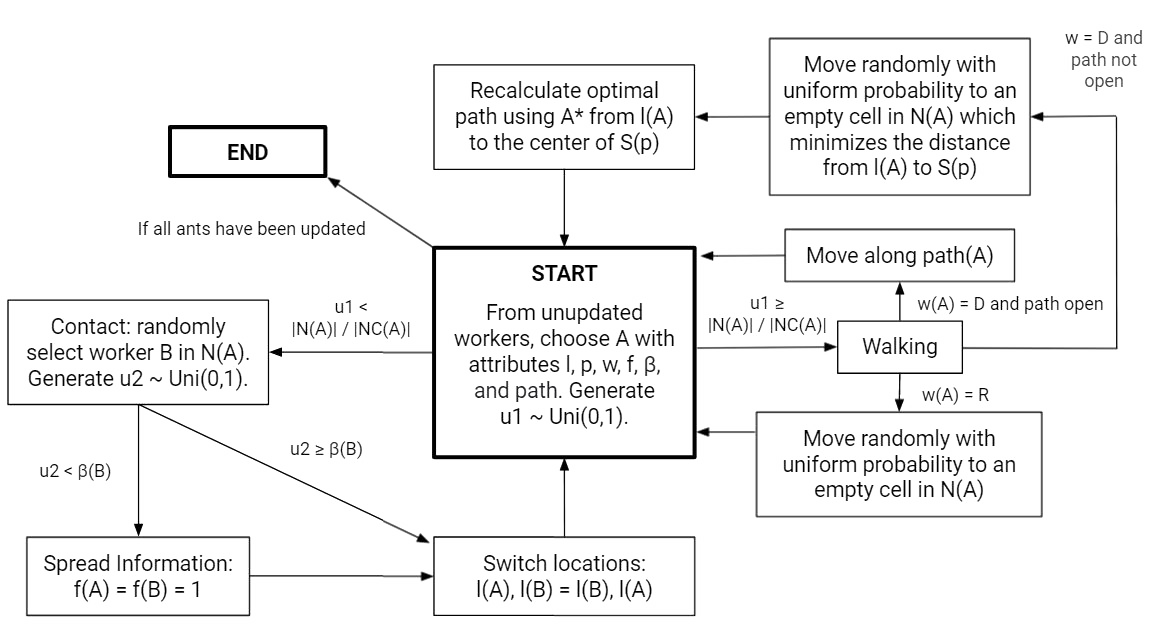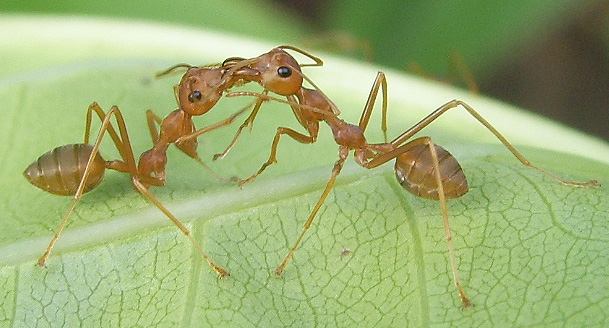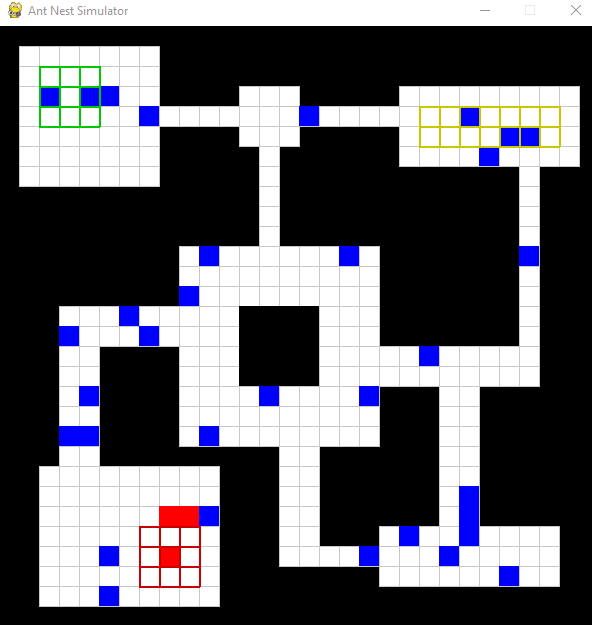REU: Social Insect Networks
6 min read
TLDR
(click to show/hide)
My second research experience was online at Arizona State University during covid. Through the labs focus on mathematical ecology,
I found a new passion in researching social insects, in particular, modeling ant behavior and how it varies by the topology of their nest.
This summer, I attended the
QRLSSP REU at
Arizona State University online. We spent the first few weeks learning
various mathematical tools for modeling topics in the life Sciences
such as pandemic simulations, population growth, immunology, etc. Many
of these are well worth spending a whole article on so look forward to
those in the coming months! After This curriculum, we spent another
four weeks in smaller groups working on projects we came up with. My
group of two undergrads, one graduate student mentor, and one faculty
mentor decided to focus on social insects.
I had seen a few interesting
videos on
ants by Kurzgesagt (a wonderful informative channel on YouTube) and
thought they would be fun to learn more about. On forming our group,
we had no idea what sorts of problems there were to study about ants,
so we spent a week reading dozens of articles from the past few
decades on social insects and how they pass information between one
another.
We learned that there are three main ways social insects pass
information; antennation, trophallaxis, and pheromonally. They are
each used to pass different types of information with antennation
being used for general purpose communication, tropallaxis for direct
transfer of food, and pheromones for nest construction and paths from
and between nests.
On the left is an example of antennation and on the right,
trophallaxis
Previous work had been done studying how ants pass information around
by making models with simple boundaries and comparing them to
experimental data. We can often tell when an ant has recieved a
message when their speed increases and movement becomes more erratic.
This is called the ants alarm response. What our group was interested
in was how information flows through a colony when interactions are
occuring within more complex nest structures. Interconnected tunnels
and chambers of various sizes are expected to have some effect on the
efficiency of this process so we wanted to understand via simulation
what the potential benefits of various nest structures might be.
The way we did this was by adapting a model from an earlier work by
Yun Kang, who we met
with several times to get recommendations on what changes could be
made.
Our Model
We went with a discrete-time agent-based model in which ants have a
number of attributes including location, task, walking style, and
information status. The nest is represented by some connected subset
. The location of ant at time
is a unique
, the task is
an natural number less than (the number of
task zones such as food processing area, brood care, etc.), walking
style is either drifted () or random (), and information status is a boolean value. The task zones
are subsets of
which represent areas of isolation seen in
real ant colonies. Our model assumes that ants will tend to segregate
themselves into their task zones and that ants which have drifted
walking style will do this by walking directly towards their task zone
when separated from it.
Initializing the simulation, ants randomly
populate the nest structure stored as a matrix and are updated
according to the following update step:

Each time step, this update step is run for all ants in a random order
Below is an example of a simulation over a couple hundred time steps.
The red tiles represent ants which have recieved an alarm signal and
the blue represents unalarmed ants. When ants interact, there is a
chance that information transfers between the two which we track as a
successful contact. The primary differences between this simulation
and a simulation based on the previous work by Dr. Kang is that the
nest structure isn't square. By allowing for
other types of connecting domains like this one, we can really begin
to explore more realistic nest shapes and how they might affect
interactions.
Notice that some ants (those with drifted walking style) will navigate
around corners to find their task zone
Something we needed to drastically change after allowing this wider
range of possibilities for was the walking
style for the ants. Previously, ants would move to the open square
nearest to the center of their respective task zone. This causes
problems in these more complex nests when the nearest tile to the task
zone is in a wall. The ant would repeatedly run into the wall never
reaching its goal (quite an unrealistic behaviour). To fix this, we
assume that over short timescales and in small nests, the ants are
aware of a path which will bring them to their task zone. With this
assumption, we can allow ants to follow an optimal path found using
A* search
until they run into another ant. Once this happens, they move out of
the way and recalculate their path.
Our Metrics
In our readings of previous papers, we found a number of ways to
analyze interactions networks. These included Spatial Heterogeneity
Degree (essentially the amount of variance in ant location over time),
total informed population over time, contact rates between and within
task groups, and the number of
motifs seen
in the time-aggregated network. We decided to track each of these
while varying density of ants in the nest, spatial fidelity
(proportion of ants which have directed walking style), and the shape
of the nest itself in order to cast a wide net searching for
interesting results.
Our Results
To capture a variety of nest structures without simulating entire
nests, we decided to simulate on basic nest components such as
chambers, loops, tunnels, and chains. What we determined is that each
of these components had different optimal conditions for information
flow (where 'optimal' means a low time to a fully informed colony). In
some cases, these conditions were the complete opposite from other
components.

Efficiency of information flow increases as density
increases for squares
Efficiency of information flow decreases as density
increases for chains
In the examples above, we see that the density of ants seems to
positively effect information flow in square shaped nests but
negatively effect information flow in chains (squares connected by
narrow tunnels). This makes sense because in squares, an increased
density means more interactions per second which leads to a fully
informed population faster. In chains however, a high density makes it
difficult for ants to navigate quickly through the tunnels between
chambers. This slows travel drastically and increases the time it
takes to inform all of the ants.
Why would ants want this? Wouldn't it be great if all nest structures
were refined to inform the population of threats and food sources as
quickly as possible?
We thought about this for a while and realized that it may have to do
with ant diseases. Ants can get poisoned by foods they retrieve or get
sick by other means and because of the ways in which they communicate
(specifically trophallaxis), contact between ants can make it highly
likely to transfer these illnesses. In a nest where information flow
is highly optimized, so is the spread of pathogens. Perhaps structures
are in place to balance out these two things. Of course, investigation
of real ant colonies is necessary to confirm or deny this, but our
model provides some insight into what we might expect to see.
There are a few other results we talk about in our actual tech report
so I encourage you to look over that in the resources if you're
interested! Thanks for reading!
Resources





